
Return to This Plant's Category: Gingers
Costus pulverulentus 'Purple Passion'

Code: 51014
Price: $18.95
Quantity in Basket: None
Family: Costaceae
This is a compact costus with beautiful dark green leaves with dark purple undersides. The green stalks are arranged in a spiral form with purple bands at the leaf bases topped with bright orange-red flowers protruding from the red cone-shaped inflorescence. This desirable plant is easy to grow and flower. Its compact height, to 4 feet, makes it a fine potted plant or landscape specimen. Give it moist well draining soil in bright shade and frost protection in the winter. It was first collected in a Panamanian garden and is considered of hybrid origin, possibly with Costus laevis as a parent. USDA zones 10 - 12. Our catalog previously listed this plant as Costus laevis in error.



(B) Hanging
basket (D) Dwarf
under 12" (F) Flourescent lights for
indoor light culture (H) Humid
conditions (M) Miniature
under 6" (T) Terrarium
plant (W) Winter
flowering
Key to USDA Hardiness Zones
